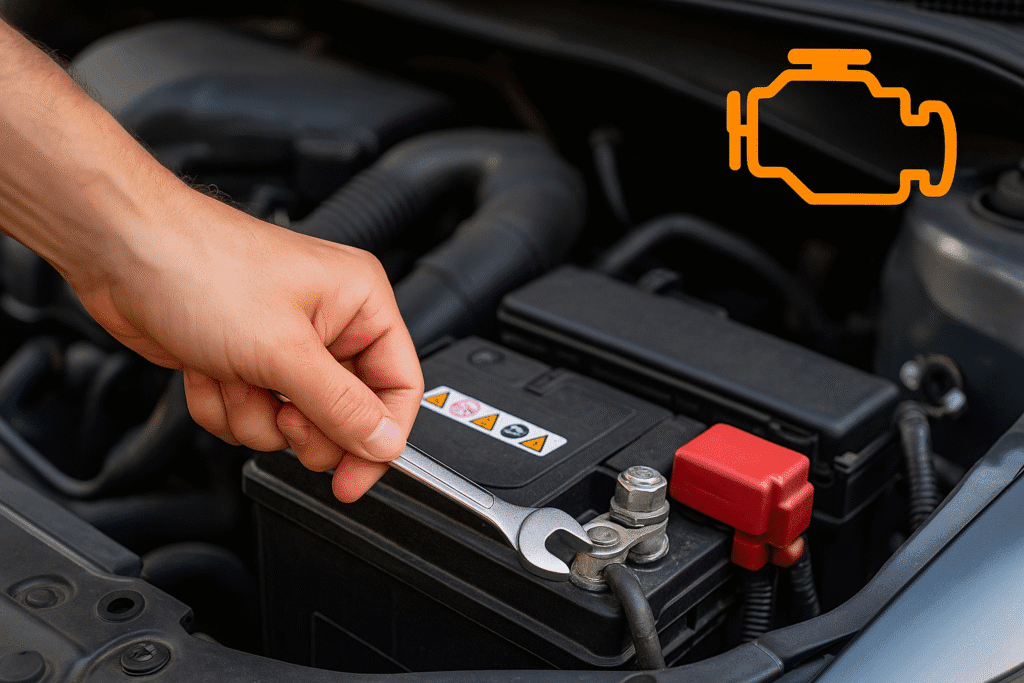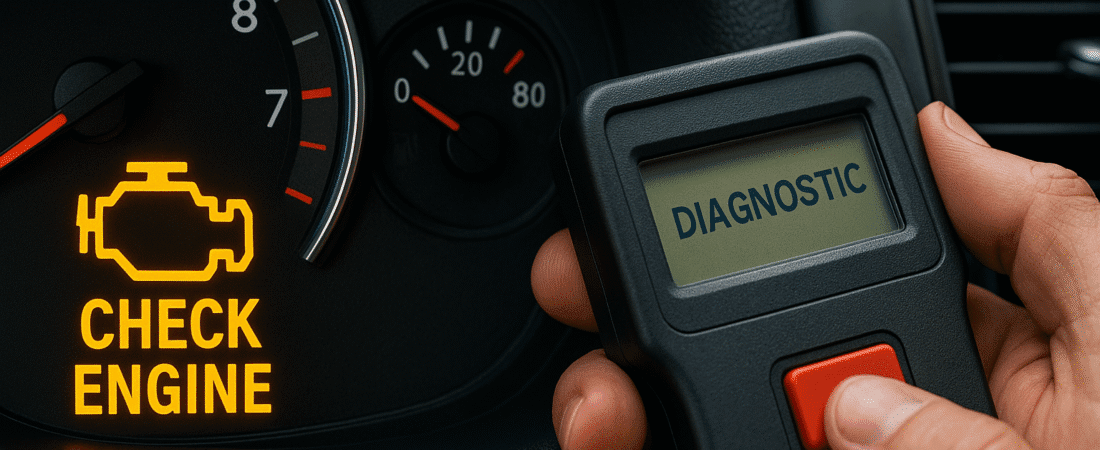You’re driving along, everything seems fine — and suddenly the dreaded check engine light appears on your dashboard.
It’s one of the most confusing and anxiety-inducing alerts a driver can face. Is it a serious engine problem? A loose gas cap? Or just a sensor glitch?
In this guide, we’ll break down what the check engine light actually means, reveal the 10 most common causes, and show you how to diagnose and fix it — with or without a mechanic. Whether you’re a seasoned DIYer or just trying to avoid a costly repair, this is your go-to resource for decoding that warning light in 2025.
What Is the Check Engine Light?

What It Indicates
The check engine light, also known as the Malfunction Indicator Lamp (MIL), is part of your car’s On-Board Diagnostics (OBD-II) system. When it turns on, it means the engine control module (ECM) has detected an issue affecting:
- Emissions
- Engine performance
- Fuel system
- Electrical components
It doesn’t always signal a catastrophic failure — but it does mean your car needs attention.
When It’s Safe to Drive
There are two types of warnings:
- Solid (steady) check engine light:
Usually safe to drive short distances. Often triggered by minor issues like a loose gas cap or sensor misread. - Flashing check engine light:
Indicates a serious problem, often related to engine misfires or potential catalytic converter damage.
🚫 Do not drive — tow the vehicle if needed.
If your car drives roughly, stalls, or emits strange smells (burning, sulfur), stop and get it checked immediately.
The Top 10 Most Common Causes
1. Loose or Damaged Gas Cap
The simplest fix of all.
A loose, cracked, or missing gas cap can trigger the check engine light because it affects fuel system pressure and emissions.
Symptoms:
- Light comes on shortly after refueling
- Slight fuel odor
Fix:
Tighten the cap until it clicks. If it’s cracked, replace it — usually under $20.
2. Faulty Oxygen Sensor (O2 Sensor)
This sensor monitors how much oxygen is in your exhaust. When it fails, the engine may run rich (too much fuel) or lean (too little).
Symptoms:
- Decreased MPG
- Rough idle
- Rotten egg smell
Fix:
A new O2 sensor costs $100–$300 installed, depending on the model. DIY-friendly with an OBD2 scanner.
3. Failing Catalytic Converter
This critical emissions component helps reduce toxic gases. If it’s clogged or failing, your vehicle will run poorly and may not pass inspection.
Symptoms:
- Reduced acceleration
- Strong sulfur smell
- Rattling sound underneath
Fix:
Often $800–$2,000 to replace. Regular maintenance prevents failure.
4. Mass Airflow Sensor (MAF) Issue
The MAF sensor controls how much air enters the engine. If it malfunctions, it throws off the air/fuel ratio.
Symptoms:
- Hesitation during acceleration
- Rough idle
- Hard starts
Fix:
Clean the sensor ($10 cleaner) or replace it ($150–$400). Easy for DIYers.
5. Bad Spark Plugs or Wires
Old or damaged plugs/wires lead to misfires — which can damage the catalytic converter and cause serious drivability issues.
Symptoms:
- Jerky acceleration
- Engine misfire
- Reduced fuel efficiency
Fix:
Replace spark plugs ($50–$100) and wires ($50–$150). Should be done every 30,000–100,000 miles depending on the type.
6. Faulty Ignition Coil
Ignition coils generate the spark for your plugs. A failed coil leads to misfires and power loss.
Symptoms:
- Engine shaking
- Backfiring
- Trouble starting
Fix:
$70–$250 to replace. Easy to spot with an OBD2 scanner showing P030X codes.
7. Vacuum Leak
Cracked vacuum hoses or intake manifolds can disrupt engine air flow, triggering the check engine light.
Symptoms:
- High idle RPM
- Whistling sound
- Poor fuel economy
Fix:
Locating the leak may require smoke testing. Hoses are cheap, but labor may cost more.
8. EGR Valve Malfunction
The Exhaust Gas Recirculation (EGR) valve helps control emissions. If stuck open or closed, it affects performance.
Symptoms:
- Knocking sounds
- Failed emissions test
- Rough idle
Fix:
Cleaning might help. Replacements usually cost $150–$400.
9. Battery or Charging Issue
Modern cars monitor voltage closely. A dying battery or failing alternator may cause warning lights, including check engine.
Symptoms:
- Dim headlights
- Clicking sound when starting
- Multiple warning lights on
Fix:
Test battery/alternator. Replacements range from $100–$400.
10. Faulty EVAP System
The Evaporative Emissions Control System prevents gas vapors from escaping. A fault here often triggers a persistent check engine light.
Symptoms:
- No obvious drivability issues
- Light comes on after fueling
Fix:
Common culprits: gas cap, purge valve, charcoal canister. Repairs range $50–$500.
How to Diagnose the Problem Yourself
Diagnosing a check engine light doesn’t always require a trip to the mechanic. With the right tools and a bit of guidance, you can often identify the issue yourself — and even fix it.
Use an OBD2 Scanner
Every car made after 1996 in the U.S. has an OBD2 port (usually under the steering column). Plug in a scanner and you’ll get a trouble code (like P0420 or P0301) that tells you where the problem is.
Recommended tools:
- 🔧 Bluetooth OBD2 Scanners (like BlueDriver or FIXD): Connect to your phone via app
- 🔧 Handheld scanners (like Innova or Autel): No phone required
🛒 Tip: These tools cost between $30 and $120 — and pay for themselves quickly by avoiding misdiagnoses.
How to Read the Codes
Once connected:
- Turn your ignition to ON (engine off)
- Scan for DTC (Diagnostic Trouble Codes)
- Look up the meaning of the code (some apps explain it automatically)
Example:
- P0171 → System too lean (likely vacuum leak or MAF sensor)
- P0442 → Small EVAP leak (often the gas cap)
Some apps even estimate repair costs or suggest fixes.
When to See a Mechanic
Even with the right tools, some problems need a professional. Seek help if:
- The code points to transmission, internal engine, or electrical system
- You see multiple unrelated codes
- The light is flashing (indicates risk of serious damage)
Use a scanner to get clarity before paying for diagnostics — many shops charge $100+ just to plug in what you can do for free.
Is It Safe to Drive With the Check Engine Light On?
Seeing the check engine light doesn’t always mean you’re in immediate danger — but it also shouldn’t be ignored. Understanding the difference between a minor issue and a critical failure can save you from costly repairs (or getting stranded).
Solid vs Flashing Check Engine Light
🟡 Solid (Steady) Light:
This usually signals a non-urgent problem, like a loose gas cap or a bad sensor. The car is typically safe to drive for short distances, but you should diagnose the issue soon.
🔴 Flashing Light:
This indicates a serious issue, often an engine misfire that could damage the catalytic converter or cause overheating.
🚫 Do NOT continue driving — pull over safely and get the car checked immediately.
Signs It’s Not Safe to Drive
Even if the light is solid, stop driving and call for help if you notice:
- Strong smells (like rotten eggs or burning plastic)
- Smoke or steam from under the hood
- Jerky acceleration or rough idle
- Dashboard lights flashing in combination
- Loss of power or stalling
🛠 In doubt? Get it towed. It’s cheaper than replacing a damaged engine or exhaust system.
Temporary Workarounds (If Driving Is Necessary)
If you must drive:
- Avoid high speeds and rapid acceleration
- Keep trips short and local
- Use an OBD2 scanner to confirm it’s not a critical code
Still, this is only a temporary measure. Don’t ignore the light for days or weeks — small issues can escalate fast.
How to Reset the Check Engine Light (Safely)

Resetting the check engine light can be tempting — but doing it the wrong way can hide problems and make things worse. Here’s how to do it the right way, and when it’s best to avoid it.
The Right Way – Use an OBD2 Scanner
Most OBD2 scanners have a “Clear Codes” or “Reset” function. After scanning and understanding the issue:
- Fix the problem (or confirm it’s non-critical)
- Select “Erase Codes” on the scanner
- Turn off ignition, wait 30 seconds, restart the engine
✅ If the issue was resolved, the light should stay off.
🔁 If the light returns, the problem persists and needs deeper inspection.
Should You Disconnect the Battery?
This old-school method resets the ECM by cutting power:
- Disconnect negative terminal of battery for 10–15 minutes
- Reconnect, then restart the car
⚠️ Use with caution:
- May erase radio presets, clock, and other settings
- Doesn’t fix the actual issue
- May delay reappearance of the warning, masking a real problem
When NOT to Reset the Light
Never reset the light before scanning the code — you’ll lose important info.
Also avoid resetting if:
- The issue hasn’t been fixed
- You plan to take the car for emissions or inspection soon
- The light is flashing
Important: Some codes require multiple drive cycles to clear automatically once the issue is resolved — no manual reset needed.
Final Tips: Preventing Future Check Engine Issues
Keeping the check engine light off starts with regular, smart maintenance. Here’s how to avoid surprises:
Stay on Top of Oil Changes and Tune-Ups
Old oil, worn spark plugs, and dirty air filters can all trigger warning lights over time.
Tighten the Gas Cap Every Time You Fuel Up
It’s simple but often overlooked — and one of the most common causes.
Use Quality Fuel and Parts
Cheap gas and aftermarket parts sometimes cause sensor issues or premature wear.
Keep an OBD2 Scanner in Your Glove Box
It’s a small investment that puts you in control and can save you hundreds in diagnostics.
Act Fast, Not Frantic
The check engine light is a warning — not a death sentence. Stay calm, check the code, and handle the issue accordingly.
Frequently Asked Questions
Can I drive with the check engine light on?
Yes — if it’s solid and the car is running normally. But if it’s flashing, pull over and get help immediately. Always scan the code as soon as possible.
What’s the most common cause of the check engine light?
A loose or damaged gas cap is the most frequent trigger. It affects the EVAP system and emissions.
How do I know if it’s serious?
If the light is flashing, or if you notice symptoms like engine misfire, rough idle, or strange smells, stop driving and call a mechanic.
How much does it cost to fix check engine light issues?
It varies. Some fixes cost under $20 (gas cap), while others like a catalytic converter can exceed $1,000. Using a scanner helps you know what you’re facing.
Will the light turn off by itself?
Yes — if the issue is resolved, many systems will clear the code automatically after a few drive cycles. Otherwise, use a scanner to reset it manually.
